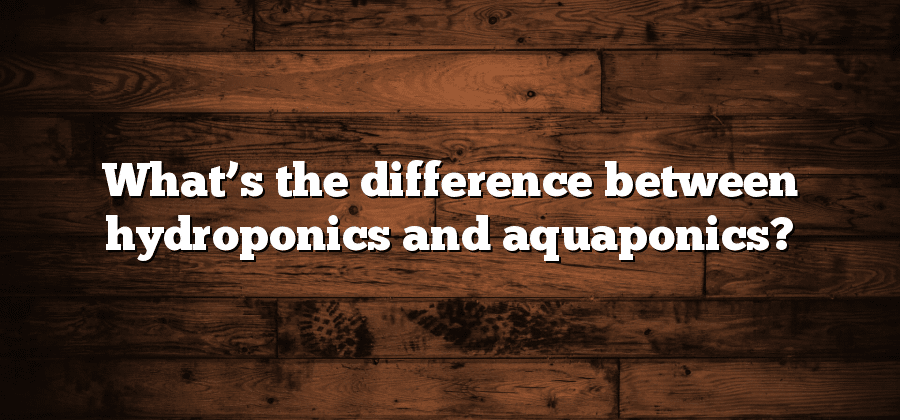Hydroponics: A Soilless Cultivation Method
Hydroponics is an innovative soilless cultivation method that is gaining popularity among farmers, horticulturists, and gardening enthusiasts. Instead of relying on traditional soil-based methods, hydroponics focuses on providing plants with the necessary nutrients through a water-based system. This unique approach offers several advantages, including increased control over plant growth, reduced water usage, and optimized use of space.
One of the primary advantages of hydroponics is that it allows for the precise control of nutrient delivery to plants. By using a nutrient-rich water solution, growers can ensure that plants receive the perfect balance of essential nutrients at all stages of their growth. This eliminates any reliance on the nutrient content of the soil, which can often be inconsistent and variable. Furthermore, the ability to monitor and adjust nutrient levels in real-time enables growers to maximize plant health and productivity, resulting in higher yield and quality crops.
Aquaponics: A Symbiotic Growing System
Aquaponics is a unique and innovative approach to cultivating plants that harnesses the power of symbiosis. This system combines aquaculture, the practice of rearing fish, with hydroponics, the method of growing plants in water. The result is a mutually beneficial relationship where both the fish and the plants thrive together.
In an aquaponics system, fish are kept in tanks, and their waste products, in the form of ammonia-rich water, are then filtered and pumped into the plant growing beds. The plants, in turn, use the nutrients from the fish waste as their primary source of nutrition. As the plants absorb these nutrients, they help to purify the water, creating a healthy environment for the fish to live in. This symbiotic relationship not only eliminates the need for traditional soil but also minimizes water usage, making aquaponics a highly sustainable and efficient method of cultivation.
Hydroponics Explained: Water-Based Plant Cultivation
Hydroponics, a unique cultivation method that relies on water rather than soil, has gained popularity in recent years. This innovative technique allows plants to grow in a controlled environment, with the roots immersed in a nutrient-rich solution. By eliminating the need for soil, hydroponics offers numerous advantages, including increased growth rates and improved crop yields. In this water-based plant cultivation system, the nutrient solution is carefully balanced to provide all the necessary elements for optimal plant development.
One key benefit of hydroponics is its ability to minimize water usage. Unlike traditional soil-based farming, hydroponics recirculates the nutrient solution, significantly reducing the amount of water needed to grow plants. This makes it an appealing choice in regions facing water scarcity or drought conditions. Additionally, since the nutrients are delivered directly to the roots, plants in a hydroponic system can absorb them more efficiently, leading to faster growth and healthier crops.
Aquaponics Discussed: Combining Fish and Plants
Aquaponics is an innovative and sustainable method of cultivating plants that combines fish and plants in a symbiotic ecosystem. Unlike traditional farming techniques, aquaponics harnesses the power of nature to create a self-sustaining environment that benefits both the fish and the plants.
In an aquaponics system, the fish provide the necessary nutrients for the plants by producing waste. This waste is then converted into a nutrient-rich solution by bacteria in the water. The plants, in turn, absorb these nutrients, effectively filtering the water for the fish. This natural cycle of nutrient exchange creates a closed-loop system where both the fish and the plants thrive without the need for soil.
By integrating fish and plants in one ecosystem, aquaponics offers numerous advantages. Firstly, it eliminates the need for artificial fertilizers as the fish waste acts as a natural and sustainable source of nutrients. Additionally, the plants provide a natural filtration system for the fish, ensuring clean and oxygenated water. This method also requires significantly less water compared to traditional farming, making it a viable solution in regions with water scarcity. Moreover, aquaponics allows for year-round cultivation, providing a consistent and reliable food source regardless of the season.
Overall, aquaponics is a highly efficient and environmentally friendly method of growing plants. It exemplifies the potential for sustainable agriculture and offers a glimpse into the future of farming. With its ability to combine fish and plants in a harmonious ecosystem, aquaponics presents exciting opportunities for food production worldwide.
Hydroponics: Nutrient Solution for Growth
The success of hydroponics as a soilless cultivation method lies in the careful composition of the nutrient solution. Unlike traditional soil-based gardening, where nutrients are absorbed by plants through the soil, hydroponics relies on the precise delivery of nutrients directly to the plant roots in a water-based solution. This nutrient solution is carefully formulated to provide all the essential elements required for healthy plant growth.
In a hydroponic system, the nutrient solution is a balanced blend of essential minerals and elements such as nitrogen, phosphorus, and potassium, along with trace elements like iron, manganese, and zinc. These nutrients are dissolved in water, creating a highly concentrated solution that can be easily absorbed by the plant roots. By tailoring the nutrient solution to meet the specific needs of the plants being grown, hydroponic growers can ensure optimal nutrient uptake, leading to faster growth rates, increased yields, and improved overall plant health.
By removing the need for soil, hydroponics allows for more control over the nutrient availability and uptake by plants. Growers can easily monitor and adjust the nutrient solution to ensure that the plants receive the ideal balance of nutrients at each stage of growth. This level of precision enables plants to easily access the necessary nutrients without expending energy on searching for them in the soil. As a result, plants can direct more energy towards productive growth, leading to healthier and more vigorous plants. Furthermore, the nutrient solution in hydroponics can be recirculated, reducing waste and allowing for the efficient use of resources.






